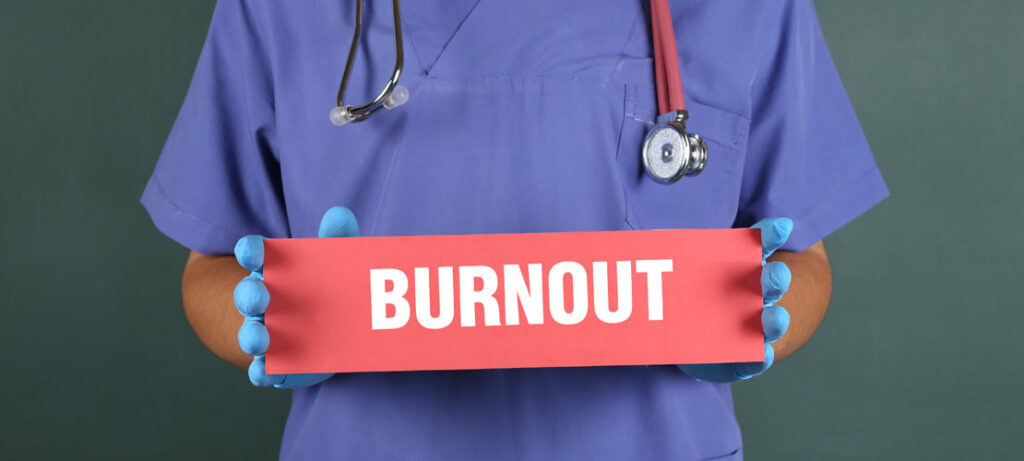Burnout—also called compassion fatigue or secondary traumatic stress—in the medical profession can be devastating. Burnout leads to depression, medical errors, high turnover rates, and even suicide. For decades, caretakers across the spectrum of medical fields have experienced serious symptoms of burnout.
What Does Burnout Look Like?
According to the Agency for Healthcare Research and Quality, burnout is a “long term stress reaction marked by emotional exhaustion, depersonalization, and a lack of sense of personal accomplishment.” It causes frustration, discouragement, and fatigue, which lead to cynicism, anger management issues, and depression.
Burnout Isn’t a New Phenomenon
A recent study by Medscape states that the number of healthcare workers experiencing burnout didn’t increase significantly as a result of COVID. What did change, however, was which specialties reported the highest instances of burnout. In 2021, physicians most affected by burnout worked in critical care, rheumatology and infectious diseases in healthcare organizations and outpatient clinics, whereas in 2020 the specialties most affected were urology, neurology and nephrology. Nurses most likely to experience burnout work in the ED, perinatal departments, and the NICU.
The Impact of Burnout
The symptoms of burnout radiate from the medical care team to their families, affecting their home life and relationships.
Burnout also damages patient care quality. Exhausted and overworked healthcare professionals report being more easily exasperated with patients. They find it harder to pay attention and are twice as likely to make medical errors such as giving incorrect diagnoses or writing wrong prescriptions.
Burnout Affects Patient Care: Now and in the Future
Many nurses and physicians consider leaving their profession because of the effects of burnout on their personal and professional lives. This reduces accessibility to care and makes hospitals and clinics even less efficient. Fewer staff are available to care for patients and the continuity of care is disrupted. The cost for a hospital to replace each nurse who leaves averages $90,000 and the cost to recruit and replace a physician can be between $500,000-$1,000,000.
The U.S. Department of Health and Human Services is predicting a significant shortage of physicians in the next 5-10 years. Burnout must be reduced in order to improve the quality and accessibility of healthcare.
Causes of Burnout
Recent studies illuminate ways that the current culture of healthcare is actually at the root of this burnout crisis.
According to nurses surveyed, their top three causes of burnout are:
- chaotic work environment
- time-consuming bureaucratic tasks
- lack of effective teamwork
Physicians’ top three causes of burnout are similar:
- too many bureaucratic tasks
- too long of work hours
- increased yet ineffective technology
Root Cause of Burnout: Bad Communication
Many of these causes have a similar root: communication problems. Chaos is caused by not knowing whom to contact, where to find them, or whether they’ve received a message. Poor communication breaks down the ability of teams to work together. It raises barriers where there may have been none before. Even something as simple as being unable to turn off a pager–for fear of missing an urgent notification–blurs the work/home balance and adds extra hours to an already long day.
An effective way to improve culture–and reduce burnout–in any profession, is with better communication. While many technological advances have been made with the goal of improving efficiency, these “advances” have resulted in time consuming, redundant tasks that actually hinder clear, immediate communication. In fact, Becker Hospital Review reports that “ninety percent of all clinical staff at U.S. hospitals and health systems agreed that increased or ineffective technology contributes to the risk of clinician burnout.”
Improve Communication Technology to Reduce Burnout
Unfortunately, even well-intentioned tech devices can add chaos, increase bureaucratic tasks, and they confuse teamwork by muddling communication.
Mobile tech done right will clarify communication, which will improve the overall organizational culture and lead to greater rates of satisfaction among healthcare workers.
Mobile communication features like these are specifically designed to reduce burnout:
- Critical Alerts for High Priority Messages
On call physicians need to know when they receive an urgent message, even if they’ve muted their devices to catch a few precious hours of sleep. With many communication platforms or devices on the market today, providers either receive every message or none at all. Limit unnecessary interruptions and give providers the confidence that they won’t miss the important messages. Create a unique, audible tone that providers can recognize at any time–even if they’re asleep.
- Read Receipts
Traditionally, when a provider receives a message — whether by phone or pager — they have to call back to report that the message was received and to give their answer. In-app Read Receipts eliminate this step by automatically marking when the person received and opened a message, and giving them the option of selecting a pre-populated reply.
- Nurse Call Notifications
Reduce chaos and save nurses time by creating notifications that are tailored to each nurse’s unit. Team members can receive notifications on their handheld devices and know which alerts are highest priority. This way, they won’t need to stop what they’re doing to return to the nurse’s station and investigate.
- Code Notifications
Teams can work more effectively when they can communicate immediately whether they’re in-person or in various parts of the building. Code notifications are the fastest, easiest way to notify an entire team of emergent situations. When used with Read Receipts and Critical Alerts, every member of the team can be certain that the right people are on their way.
- Multi-Media Messaging
While images can be saved and uploaded to an EHR, accessing those records while communicating with other members of a care team takes up precious time when a decision is needed. Enable secure picture, video and report messaging so remote and in-person team members can review results and communicate immediately.
Clear, immediate, two-way communication between all members of a care team will improve efficiency, reduce misunderstandings, limit time wasted looking for “the right person,” and give healthcare providers more time to do what they want to do most: care for patients.
As healthcare organizations improve their internal communication technology, provider job satisfaction rates will increase and they’ll be able to give better care to their patients.
If your nurses and physicians are experiencing burnout, consider the technology used to communicate with them. Perhaps an updated, streamlined service will make the difference for your organization.





